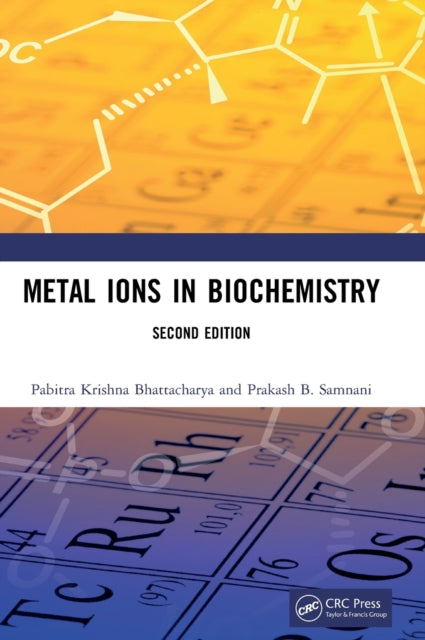Pabitra Krishna Bhattacharya,Prakash B. Samnani
Metal Ions in Biochemistry
Metal Ions in Biochemistry
YOU SAVE £4.32
- Condition: Brand new
- UK Delivery times: Usually arrives within 2 - 3 working days
- UK Shipping: Fee starts at £2.39. Subject to product weight & dimension
Bulk ordering. Want 15 or more copies? Get a personalised quote and bigger discounts. Learn more about bulk orders.
Couldn't load pickup availability
- More about Metal Ions in Biochemistry
The second edition of "Metal Ions in Biochemistry" explores the multidisciplinary field of bio-inorganic chemistry, focusing on the roles of metal ions in biochemistry, including brain chemistry, glucose metabolism, and haemoglobin synthesis. It also discusses the use of metal complexes and inorganic ions as therapeutics, such as iron for leukaemia, iodine for hypothyroidism, and zinc for COVID-19 prevention and treatment.
Format: Hardback
Length: 274 pages
Publication date: 14 December 2020
Publisher: Taylor & Francis Ltd
The second edition of Metal Ions in Biochemistry delves into the intricate realm of bio-inorganic chemistry, seamlessly integrating disciplines such as inorganic chemistry, biochemistry, and medicine. This comprehensive text explores the profound role of metal ions in biochemistry, emphasizing that biochemistry primarily revolves around the study of metal-biochemical complexes. Consequently, the book commences by delving into the structures of biochemicals, identifying their crucial metal binding sites. It then proceeds to elucidate the thermodynamic and kinetic properties of these complexes, shedding light on the nature of metal-ligand bonds. Furthermore, the book delves into the diverse catalytic and structural roles of metal ions in biochemicals, providing a detailed account of their significance.
One of the key chapters in this edition focuses on the role of Na+ and K+ in brain chemistry. It sheds light on the mechanisms by which these ions regulate neuronal excitability and neurotransmitter release. Additionally, the book discusses the role of zinc insulin in glucose metabolism, highlighting the potential of vanadium and chromium compounds to enhance its effects. The discussion also encompasses the role of zinc signals, zinc fingers, and cascade effects in biochemistry, providing valuable insights into the complex regulatory networks of biological systems.
Another noteworthy aspect of the book is its comprehensive coverage of haemoglobin synthesis and the role of vitamin B12 in this process. It sheds light on the mechanisms by which haemoglobin is produced and the importance of vitamin B12 in maintaining healthy red blood cells. Furthermore, the book explores the role of lanthanides in biochemical systems, emphasizing their unique properties and applications.
In addition to its focus on metal ions, the second edition of Metal Ions in Biochemistry also addresses the topic of non-metals in biochemistry, a subject that is often overlooked in other books on bio-inorganic chemistry. This chapter provides a detailed exploration of the roles of non-metals in various biochemical reactions, highlighting their significance in cellular processes.
The study of bio-inorganic chemistry has a profound impact on biochemists, prompting them to reevaluate the mechanistic pathways of biochemical reactions mediated by metal ions. It fosters a deeper understanding of the role of metal complexes and inorganic ions as therapeutics, such as iron in the treatment of leukaemia, thalassemia, and sickle cell anaemia. Iodine is also recognized for its therapeutic benefits in hypothyroidism, while zinc, vanadium, and chromium have been shown to play crucial roles in glucose metabolism.
The most recent realization in the field of bio-inorganic chemistry is the remarkable use of zinc in the prevention and treatment of COVID-19. Zinc has been shown to have antiviral properties and has been widely used as a supplement to support immune function and reduce the risk of infection. This discovery has underscored the importance of understanding the role of metal ions in biochemistry and their potential applications in healthcare.
In conclusion, the second edition of Metal Ions in Biochemistry is a valuable resource for students, researchers, and professionals in the fields of biochemistry, inorganic chemistry, and medicine. It provides a comprehensive and up-to-date account of the role of metal ions in biochemistry, emphasizing their structures, properties, and therapeutic applications. With its multidisciplinary approach, the book offers a deeper understanding of the complex interplay between metal ions and biological systems, paving the way for future advancements in this field.
Weight: 718g
Dimension: 184 x 260 x 23 (mm)
ISBN-13: 9780367622251
Edition number: 2 New edition
This item can be found in:
UK and International shipping information
UK and International shipping information
UK Delivery and returns information:
- Delivery within 2 - 3 days when ordering in the UK.
- Shipping fee for UK customers from £2.39. Fully tracked shipping service available.
- Returns policy: Return within 30 days of receipt for full refund.
International deliveries:
Shulph Ink now ships to Australia, Belgium, Canada, France, Germany, Ireland, Italy, India, Luxembourg Saudi Arabia, Singapore, Spain, Netherlands, New Zealand, United Arab Emirates, United States of America.
- Delivery times: within 5 - 10 days for international orders.
- Shipping fee: charges vary for overseas orders. Only tracked services are available for most international orders. Some countries have untracked shipping options.
- Customs charges: If ordering to addresses outside the United Kingdom, you may or may not incur additional customs and duties fees during local delivery.


